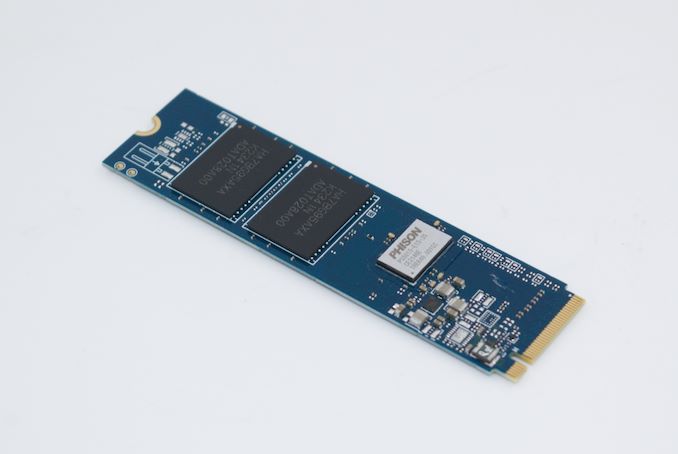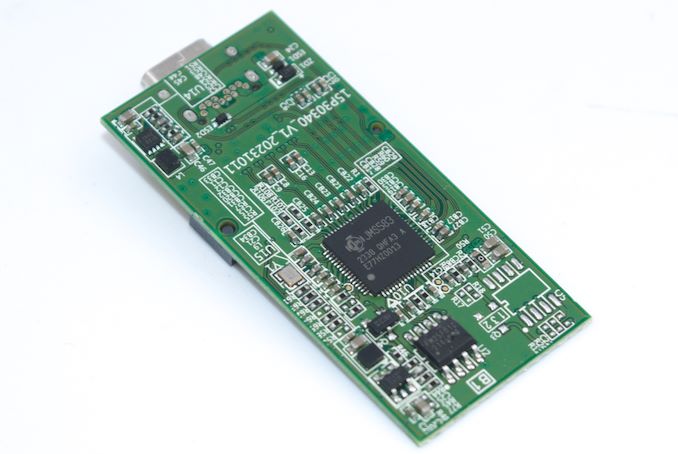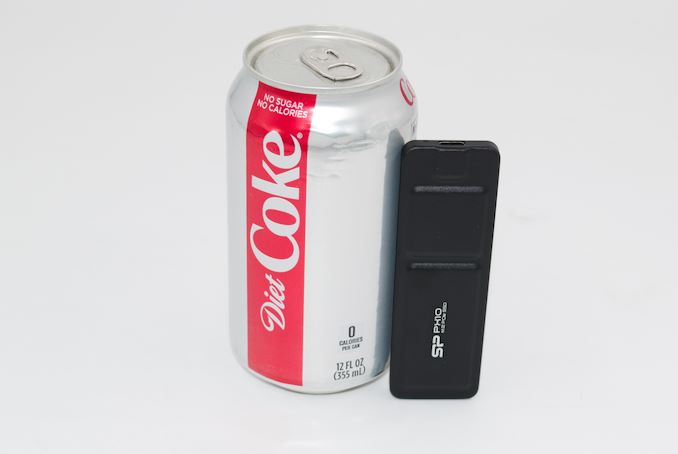
Original Link: https://www.anandtech.com/show/21284/silicon-power-px10-portable-ssd-review-
Silicon Power PX10 Portable SSD Review: One Step Forward, Two Steps Back
by Ganesh T S on March 4, 2024 8:00 AM EST- Posted in
- Storage
- SSDs
- JMicron
- Silicon Power
- Portable SSDs

Silicon Power's product lines have made their mark in the entry-level market with aggressive pricing. In late 2023, the company introduced a number of portable flash-based storage devices - the MS70 / DS72 thumb drives with SSD-class performance (using the Phison U17 native UFD controller), and the PX10 portable SSD in a gumstick form-factor.
The PX10 targets power users and professionals with better performance consistency compared to the thumb drives, despite all of them belonging to the 1 GBps category. Silicon Power has adopted a traditional bridge-based design for this product, placing a M.2 2280 Gen 3 x4 NVMe SSD behind a USB 3.2 Gen 2 (10 Gbps) bridge chip.
This review takes a detailed look at the internals of the PX10, followed by a discussion of the results of putting it through our rigorous direct-attached storage performance evaluation routine. Prior to discussing the value proposition, we also look at the power consumption and thermal profile of the product.
Introduction and Product Impressions
Portable SSDs have experienced significant market growth, prompting silicon vendors like Phison and Silicon Motion to create single-chip native USB flash drive (UFD) controllers. Almost all of the recent product introductions in this category have incorporated them to offer compelling performance at very attractive price points (BOM savings due to lesser number of chips on the board) while also being power efficient.
In this market situation, Silicon Power's PX10 comes in as a bridge-based offering that is able to hit the price points of the single-chip PSSDs in the market. The form-factor of the PSSD reflects the underlying M.2 2280 NVMe SSD's gumstick nature. Silicon Power supplies a nylon-braided 30cm USB 3.2 Gen 2 Type-C to Type-C cable in the package.
The case is held together by plastic tabs (the top part of the PX10 is aluminum, while the bottom segment is polycarbonate). It can be pried open to reveal the internals.
The case has a stylish, yet solid feel to it, with the metal top and thin nature adding to its allure. Silicon Power claims that the PX10 has a MIL-STD 810H (Method 516.8) certification, indicating shock-proofing with an element of ruggedness.
Silicon Power equips the PX10 with its P34A60 M.2 2280 Gen 3 x4 NVMe SSD. This model was launched in late 2019 with a Silicon Motion SM2263XT controller and Intel's 64L 3D TLC. The company is now manufacturing these SSDs with Phison's E15T controller and (likely) SK hynix's V7 176L 3D TLC. Our PX10 review sample was with the Phison-based SSD.
The main board uses the JMicron JMS583 bridge chip. This was quite popular in the initial wave of NVMe SSD enclosures back in 2018, but ended up causing significant consumer grief with newer platforms from late 2019 onwards. JMicron ended up having to spin out new silicon revisions. The PX10 uses the latest and greatest A3 silicon (fourth revision), but this is still a 2018-generation product.
The PX10 supports S.M.A.R.T passthrough, as shown in the CrystalDiskInfo screenshot below.
| Comparative Direct-Attached Storage Devices Configuration | ||
| Aspect | ||
| Downstream Port | PCIe 3.0 x2 | PCIe 3.0 x2 |
| Upstream Port | USB 3.2 Gen 2 Type-C | USB 3.2 Gen 2 Type-C |
| Bridge Chip | JMicron JMS583 | ASMedia ASM2362 |
| Power | Bus Powered | Bus Powered |
| Use Case | Light-weight 1GBps-class portable SSD in a gumstick form-factor with focus on style and consistency | Light-weight 1GBps-class portable SSD with a security focus (fingerprint reader integrated) |
| Physical Dimensions | 103.4 mm x 33 mm x 10.3 mm | 85 mm x 57 mm x 8 mm |
| Weight | 33 grams | 58 grams |
| Cable | 30 cm USB 3.2 Gen 2 Type-C to Type-C | 30 cm USB 3.2 Gen 2 Type-C to Type-C 30 cm USB 3.2 Gen 2 Type-C to Type-A |
| S.M.A.R.T Passthrough | Yes | Yes |
| UASP Support | Yes | Yes |
| TRIM Passthrough | Yes | Yes |
| Hardware Encryption | No | Yes |
| Evaluated Storage | 4x 256GB HA7BG95AXA Packages (SK hynix V7 176L 3D TLC) | Samsung 92L V-NAND (5th Gen.) |
| Price | USD 90 | USD 160 |
| Review Link | Silicon Power PX10 1TB Review | Samsung Portable SSD T7 Touch 1TB Review |
Prior to looking at the benchmark numbers, power consumption, and thermal solution effectiveness, a description of the testbed setup and evaluation methodology is provided.
Testbed Setup and Evaluation Methodology
Direct-attached storage devices (including thumb drives) are evaluated using the Quartz Canyon NUC (essentially, the Xeon / ECC version of the Ghost Canyon NUC) configured with 2x 16GB DDR4-2667 ECC SODIMMs and a PCIe 3.0 x4 NVMe SSD - the IM2P33E8 1TB from ADATA.
The most attractive aspect of the Quartz Canyon NUC is the presence of two PCIe slots (electrically, x16 and x4) for add-in cards. In the absence of a discrete GPU - for which there is no need in a DAS testbed - both slots are available. In fact, we also added a spare SanDisk Extreme PRO M.2 NVMe SSD to the CPU direct-attached M.2 22110 slot in the baseboard in order to avoid DMI bottlenecks when evaluating Thunderbolt 3 devices. This still allows for two add-in cards operating at x8 (x16 electrical) and x4 (x4 electrical). Since the Quartz Canyon NUC doesn't have a native USB 3.2 Gen 2x2 port, Silverstone's SST-ECU06 add-in card was installed in the x4 slot. All non-Thunderbolt devices are tested using the Type-C port enabled by the SST-ECU06.
The specifications of the testbed are summarized in the table below:
| The 2021 AnandTech DAS Testbed Configuration | |
| System | Intel Quartz Canyon NUC9vXQNX |
| CPU | Intel Xeon E-2286M |
| Memory | ADATA Industrial AD4B3200716G22 32 GB (2x 16GB) DDR4-3200 ECC @ 22-22-22-52 |
| OS Drive | ADATA Industrial IM2P33E8 NVMe 1TB |
| Secondary Drive | SanDisk Extreme PRO M.2 NVMe 3D SSD 1TB |
| Add-on Card | SilverStone Tek SST-ECU06 USB 3.2 Gen 2x2 Type-C Host |
| OS | Windows 10 Enterprise x64 (21H1) |
| Thanks to ADATA, Intel, and SilverStone Tek for the build components | |
The testbed hardware is only one segment of the evaluation. Over the last few years, the typical direct-attached storage workloads for memory cards have also evolved. High bit-rate 4K videos at 60fps have become quite common, and 8K videos are starting to make an appearance. Game install sizes have also grown steadily even in portable game consoles, thanks to high resolution textures and artwork. Keeping these in mind, our evaluation scheme for portable SSDs and UFDs involves multiple workloads which are described in detail in the corresponding sections.
- Synthetic workloads using CrystalDiskMark and ATTO
- Real-world access traces using PCMark 10's storage benchmark
- Custom robocopy workloads reflective of typical DAS usage
- Sequential write stress test
In the next section, we have an overview of the performance of the Silicon Power PX10 in these benchmarks. Prior to providing concluding remarks, we have some observations on the PSSD's power consumption numbers and thermal solution also.
Performance Benchmarks
Benchmarks such as ATTO and CrystalDiskMark help provide a quick look at the performance of the direct-attached storage device. The results translate to the instantaneous performance numbers that consumers can expect for specific workloads, but do not account for changes in behavior when the unit is subject to long-term conditioning and/or thermal throttling. Yet another use of these synthetic benchmarks is the ability to gather information regarding support for specific storage device features that affect performance.
Synthetic Benchmarks - ATTO and CrystalDiskMark
Benchmarks such as ATTO and CrystalDiskMark help provide a quick look at the performance of the direct-attached storage device. The results translate to the instantaneous performance numbers that consumers can expect for specific workloads, but do not account for changes in behavior when the unit is subject to long-term conditioning and/or thermal throttling. Yet another use of these synthetic benchmarks is the ability to gather information regarding support for specific storage device features that affect performance.
Silicon Power claims read and write speeds of 1050 MBps, and these are backed up by the ATTO benchmarks provided below. ATTO benchmarking is restricted to a single configuration in terms of queue depth, and is only representative of a small sub-set of real-world workloads. It does allow the visualization of change in transfer rates as the I/O size changes, with advertised performance being reached around 256 KB for a queue depth of 4.

The trip-up in the gaming workload pushes down the PX10 to the second spot in the overall scores, but it is still within touching distance of the DT Max (which actually performs quite badly in the performance consistency test).
Miscellaneous Aspects and Concluding Remarks
The performance of the portable SSDs in various real-world access traces as well as synthetic workloads was brought out in the preceding sections. We also looked at the performance consistency for these cases. Power users may also be interested in performance consistency under worst-case conditions, as well as drive power consumption. The latter is also important when used with battery powered devices such as notebooks and smartphones. Pricing is also an important aspect. We analyze each of these in detail below.
Worst-Case Performance Consistency
Flash-based storage devices tend to slow down in unpredictable ways when subject to a large number of small-sized random writes. Many benchmarks use that scheme to pre-condition devices prior to the actual testing in order to get a worst-case representative number. Fortunately, such workloads are uncommon for direct-attached storage devices, where workloads are largely sequential in nature. Use of SLC caching as well as firmware caps to prevent overheating may cause drop in write speeds when a flash-based DAS device is subject to sustained sequential writes.
Our Sequential Writes Performance Consistency Test configures the device as a raw physical disk (after deleting configured volumes). A fio workload is set up to write sequential data to the raw drive with a block size of 128K and iodepth of 32 to cover 90% of the drive capacity. The internal temperature is recorded at either end of the workload, while the instantaneous write data rate and cumulative total write data amount are recorded at 1-second intervals.
| CrystalDiskMark Workloads - Power Consumption | |
| TOP: | BOTTOM: |
 |
|
The PX10 has a peak power consumption of 4.35 W and a minimum consumption of 1.21 W. There seems to be no 'deep sleep' mode. The PX10 cuts a sorry figure in terms of power efficiency compared to the other products in the comparison list.
Final Words
The Silicon Power PX10 is currently available in three capacities - $90 for 1 TB, $140 for 2 TB, and $220 for the 4 TB version. These are aggressive price points that match / better the ones based on native UFD controllers (such as the PNY Pro Elite V2).
Based on the evaluation of different portable SSDs and the current pricing, it is clear that the performance and the value proposition (performance per dollar) for the Silicon Power PX10 is very compelling. The PX10 scores well on the consistency front too. Our main cause for concern is the use of an outdated JMicron JMS583 bridge chip resulting in disappointing power consumption numbers. An additional effect is the requirement for a better thermal solution. The metal top succeeds in dissipating some of the heat. The polycarbonate underside, despite the affixing of a thermal pad, doesn't appear to help much. As a result, the drive does seem to thermally throttle - the saving grace for the PX10 is that its competition suffers from performance loss due to running out of the SLC cache much earlier in the stress routine.

6 TB+ writes and 4 TB+ reads at the end of our testing routine
The Silicon Power PX10 presents an excellent value proposition. At its price point, it is easy to look past the power efficiency and thermal profile issues. A more judicious choice of a bridge chip and better focus on the internal SSD power consumption profile could have made the PX10 an even more compelling choice than what it is in its current avatar.
















